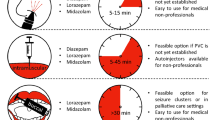Abstract
Diphenhydramine (DPH), an H1-antihistamine, is identified during postmortem toxicological analyses on a relatively rare but still regular basis. This study examines suicidal intoxications with DPH by analyzing blood and gastric content concentration levels. Twenty cases of DPH intoxications within a 10-year period (2000–2010) were discovered by screening the autopsy records of the Institute of Legal Medicine and Forensic Sciences (ILMFS) in Berlin, Germany. In four cases, DPH levels were lower than 1 μg/mL and hence were not considered likely to be responsible for causing death. In 11 cases, DPH played a role in the fatal episode, and five of these cases were monointoxications. Considering that more than 8,000 autopsies were performed by the ILMFS within the time period under examination, there is only one monointoxication case every 2 years, which makes it a rare occurrence. In two of these intoxications, DPH was only measured in toxic but not “lethal” concentrations in blood, with a concentration of 5 μg/mL being generally used as the cut off between categories according to forensic literature. This raises the question as to whether a strict boundary for a “lethal” blood concentration, as suggested in some literature, can be set and applied in any of these cases. This study shows that an individual interpretation of each case is of utmost importance for correct classification. A thorough toxicological analysis of peripheral venous blood and gastric content, as well as a detailed work-up of the death circumstances, are the basis of an exact interpretation of intoxications with DPH.



Similar content being viewed by others
References
Simons FER. Advances in H1-antihistamines. N Engl J Med. 2004;351(21):2203–17.
Nine JS, Rund CR. Fatality from diphenhydramine monointoxication: a case report and review of the infant, pediatric, and adult literature. Am J Forensic Med Pathol. 2006;27(1):36–41.
Church MK, Maurer M, Simons FER, Bindslev-Jensen C, van Cauwenberge P, Bousquet J, Holgate ST, Zubier T. Global allergy and asthma European network. Risk of first-generation H(1)-antihistamines: a GA(2)LEN position paper. Allergy. 2010;65(4):459–66.
Scavone JM, Luna BG, Harmatz JS, von Moltke L, Greenblatt DJ. Diphenhydramine kinetics following intravenous, oral, and sublingual dimenhydrinate administration. Biopharm Drug Dispos. 1990;11(3):185–9.
Estelle F, Simons R. H1-receptor antagonists: safety issues. Ann Allergy Asthma Immunol. 1999;83(5):481–8.
Backer RC, Pisano RV, Sopher IM. Diphenhydramine suicide—case report. J Anal Toxicol. 1977;1(5):227–8.
Winn RE, McDonnell KP. Fatality secondary to massive overdose of dimenhydrinate. Ann Emerg Med. 1993;22(9):1481–4.
Altorfer R. Diphenhydramine poisoning (author’s transl). Schweiz Rundsch Med Prax. 1981;70(16):711–6.
Radovanovic D, Meier PJ, Guirguis M, Lorent JP, Kupferschmidt H. Dose-dependent toxicity of diphenhydramine overdose. Hum Exp Toxicol. 2000;19(9):489–95.
Pragst F, Herre S, Bakdash A. Poisonings with diphenhydramine—a survey of 68 clinical and 55 death cases. Forensic Sci Int. 2006;161(2–3):189–97.
Ramjan KA, Williams AJ, Isbister GK, Elliott EJ. “Red as a beet and blind as a bat” Anticholinergic delirium in adolescents: lessons for the paediatrician. J Paediatr Child Health. 2007;43(11):779–80.
Jeffery AD, Lytle-Saddler T. Diphenhydramine overdose in a 26-year-old woman. J Emerg Nurs. 2008;34(6):543–4.
Husain Z, Hussain K, Nair R, Steinman R. Diphenhydramine induced QT prolongation and torsade de pointes: an uncommon effect of a common drug. Cardiol J. 2010;17:509–11.
Zareba W, Moss AJ, Rosero SZ, Hajj-Ali R, Konecki J, Andrews M. Electrocardiographic findings in patients with diphenhydramine overdose. Am J Cardiol. 1997;80:1168–73.
Thakur AC, Aslam AK, Aslam AF, Vasavada BC, Sacchi TJ, Khan IA. QT interval prolongation in diphenhydramine toxicity. Int J Cardiol. 2005;98:341–3.
Jang DH, Manini AF, Trueger NS, Duque D, Nestor NB, Nelson LS, Hoffman RS. Status epilepticus and wide-complex tachycardia secondary to diphenhydramine overdose. Clin Toxicol (Phila). 2010;48(9):945–8.
Cole JB, Stellpflug SJ, Gross EA, Smith SW. Wide complex tachycardia in a pediatric diphenhydramine overdose treated with sodium bicarbonate. Pediatr Emerg Care. 2011;27(12):1175–7.
Hausmann E, Wewer H, Wellhöner HH, Weller JP. Lethal intoxication with diphenhydramine. Report of a case with analytical follow-up. Arch Toxicol. 1983;53(1):33–9.
Karch SB. Diphenhydramine toxicity: comparisons of postmortem findings in diphenhydramine-, cocaine-, and heroin-related deaths. Am J Forensic Med Pathol. 1998;19(2):143–7.
Jones J, Dougherty J, Cannon L. Diphenhydramine-induced toxic psychosis. Am J Emerg Med. 1986;4(4):369–71.
Levine B, Klette K, Radentz S, Smith ML, Smialek JE. Antihistamine concentrations in postmortem blood and liver specimens. Forensic Sci Int. 1996;81(1):73–6.
Schulz M, Schmoldt A. Therapeutic and toxic blood concentrations of more than 800 drugs and other xenobiotics. Pharmazie. 2003;58(7):447–74.
Köppel C, Ibe K, Tenczer J. Clinical symptomatology of diphenhydramine overdose: an evaluation of 136 cases in 1982 to 1985. J Toxicol Clin Toxicol. 1987;25(1–2):53–70.
Jones GR, Pounder DJ. Site dependence of drug concentrations in postmortem blood-a case study. J Anal Toxicol. 1987;11(5):186–90.
Aderjan R, Bösche J, Schmidt G. Poisoning by diphenhydramine—forensic-toxicologic interpretation of analytic results. Z Rechtsmed. 1982;88(4):263–70.
Wyngaarden JB, Seevers MH. The toxic effects of anti-histaminic drugs. J Am Med Assoc. 1951;145(5):277–82.
Lapierre YD. A review of trimipramine. 30 years of clinical use. Drugs. 1989;38(Suppl 1):17–24. discussion 49–50.
Wogoman H, Steinberg M, Jenkins AJ. Acute intoxication with guaifenesin, diphenhydramine, and chlorpheniramine. Am J Forensic Med Pathol. 1999;20(2):199–202.
Kamijo Y, Soma K, Sato C, Kurihara K. Fatal diphenhydramine poisoning with increased vascular permeability including late pulmonary congestion refractory to percutaneous cardiovascular support. Clin Toxicol (Phila). 2008;46(9):864–8.
Acknowledgments
Dr. René Gapert’s stay at the Institute of Legal Medicine and Forensic Sciences in Berlin was supported by a DAAD Research Scholarship (Deutscher Akademischer Austausch Dienst—German Academic Exchange Service Research Grant A/11/75955).
Author information
Authors and Affiliations
Corresponding author
Rights and permissions
About this article
Cite this article
Eckes, L., Tsokos, M., Herre, S. et al. Toxicological identification of diphenhydramine (DPH) in suicide. Forensic Sci Med Pathol 9, 145–153 (2013). https://doi.org/10.1007/s12024-012-9383-5
Accepted:
Published:
Issue Date:
DOI: https://doi.org/10.1007/s12024-012-9383-5




